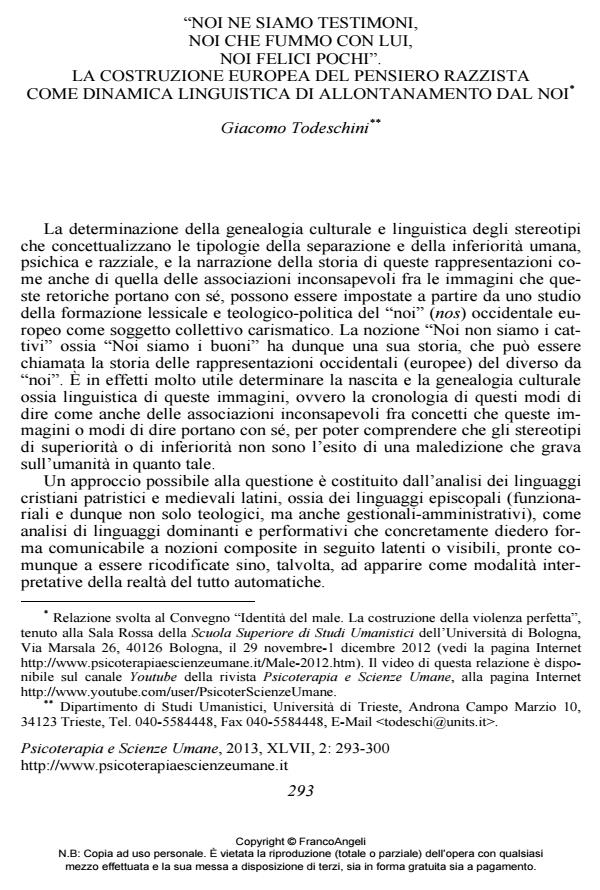"We who were witnesses, we who were with him, we happy few". European construction of the racist thought as linguistic dynamics of the removal from the "we".
Journal title PSICOTERAPIA E SCIENZE UMANE
Author/s Giacomo Todeschini
Publishing Year 2013 Issue 2013/2
Language Italian Pages 8 P. 293-300 File size 71 KB
DOI 10.3280/PU2013-002010
DOI is like a bar code for intellectual property: to have more infomation
click here
Below, you can see the article first page
If you want to buy this article in PDF format, you can do it, following the instructions to buy download credits

FrancoAngeli is member of Publishers International Linking Association, Inc (PILA), a not-for-profit association which run the CrossRef service enabling links to and from online scholarly content.
Starting from an analysis of the lexical and political-theological formation of the Western European "we" (nos) as a collective charismatic subject, we may reconstruct the cultural and linguistic genealogy of the stereotypes that have gradually defined and pictured the various typologies of human, psychological and racial separation and inferiority. The history of these representations and of the unwitting associations among the images hidden in these rhetorics allows us to read, within the racist and discriminatory discourse, a long and layered path that slowly became part of the Western European culture, and to think and perceive the relationships among people and groups.
Keywords: We, others, Christians, Jews, humanity
- Agostino (394-395 d.C.). De sermone domini in monte. In: Opere di Sant’Agostino. Roma: Città Nuova, 1976
- Agostino (418 d.C.). Lettera 196. In: Opera omnia, Vol. 21/2: Le Lettere (71-123). Roma: Città Nuova, 1992
- Agostino (429-430 d.C.). Tractatus adversus Judeos (trad. it.: Trattato contro i Giudei. Genova: Effepi, 2010).
- Berman H.J. (1983). Law and Revolution. The Formation of the Western Legal Tradition. Harvard, MA: Harvard University Press
- Brown P. (1995). Authority and the Sacred. Aspects of Christianization of the Roman World. Cambridge, MA: Cambridge University Press
- Brown P. (2002). Poverty and Leadership in the Later Roman Empire. Hanover, NH: University Press of New England (trad. it.: Povertà e leadership nel tardo impero romano. Bari: Laterza, 2003).
- Burcardo di Worms (1015). Decretorum libri XX, II, 55. In: Migne J.-P., a cura di, Patrologia Latina (PL), vol. 140, c. 635
- Burnet R. (2008). L’évangile de la trahison. Une biographie de Judas. Paris: Seuil.
- Cameron A. (1991). Christianity and the Rhetoric of the Empire. The Development of Christian Discourse. Berkeley, CA: University of California Press
- Cassiodoro (VI sec. d.C.). In psalmum 103. In: Migne J.-P., a cura di, Patrologia Latina (PL), vol. 70, c. 132.
- Chazan R. (2010). Reassessing Jewish Life in Medieval Europe. Cambridge, UK: Cambridge University Press
- Dahan G. (1990). Les intellectuels chrétiens et les juifs au moyen age. Paris: Cerf.
- Gaddis M. (2005). There is No Crime for Those Who Have Christ. Religious Violence in the Christian Roman Empire. Berkeley, CA: University of California Press
- Heller Á. (1970). A mindennapi elet. Budapest: Akadémai Kiado (trad. it.: Sociologia della vita quotidiana. Prefazione di György Lukács. Roma: Editori Riuniti, 1970).
- Higgs Strickland D. (2003). Saracens, Demons and Jews: Making Monsters in Medieval Art. Princeton, NJ: Princeton University Press
- Ivo di Chartres (1094). Decretum VI, cap. 151. Edizione su Internet: http://knowledgeforge.net/ivo/decretum/ivodec_6_1p4.pdf
- Lipton S. (1999). Images of Intolerance: The Representation of Jews and Judaism in the Bible Moralisée. Berkeley, CA: University of California Press
- Luca (80-90 d.C.). Atti degli Apostoli. Roma: CEI, 2008
- Maccoby H. (1992). Judas Iscariot and the Myth of Jewish Evil. New York: Free Press
- Mellinkoff R. (1993). Outcasts: Signs of Otherness in Northern European Art of the Late Middle Ages. Berkeley, CA: University of California Press
- Paffenroth K. (2001). Judas: Images of the Lost Disciple. Louisville, KY: Westminster John Knox Press
- Paolo (54-57 d.C.). Ad Galatas (trad. it.: Lettera ai Galati. Milano: Paoline, 2000).
- Petrocchi G., a cura di (1974). Scrittori religiosi del Duecento. Firenze: Sansoni
- Sapir Abulafia A., editor (2002). Religious Violence between Christians and Jews: Medieval Roots, Modern Perspectives. New York: Palgrave Macmillan
- Shakespeare W. (1599). The Cronicle History of Henry the fift, With his battell fought at Agin Court in France. Togither with Auntient Pistoll. London: Thomas Creede, 1600 (trad. it.: Enrico V: dramma in 5 atti. Torino: Einaudi, 1960).
- Stroumsa G.G. (1999). Barbarian Philosophy. The Religious Revolution of Early Christianity, Tübingen: Mohr Siebeck.
- Todeschini G. (2004). Dalla carnalitas all’infamia: l’evoluzione degli stereotipi antiebraici fra Medioevo ed Età Moderna. In: Fortis U., a cura di, L’antigiudaismo antico e moderno. Atti della XXVII giornata di studio (Centro di Studi Ebraici, Comunità Ebraica di Venezia, 30 marzo 2003). Torino: Zamorani, 2004, p. 59-82.
- Todeschini G. (2007). Visibilmente crudeli. Malviventi, persone sospette e gente qualunque dal medioevo all’età moderna. Bologna: Il Mulino
- Todeschini G. (2009). Gli Ebrei in Italia. In: Cavalli Sforza L.L., a cura di, La cultura italiana, Vol. I. Torino: UTET, 2009, pp. 589-633.
- Todeschini G. (2010). The Incivility of Judas: “Manifest” Usury as a Metaphor for the “Infamy of Fact” (infamia facti). In: Vitullo J. & Wolfthal D., editors, Money, Morality and Culture in Late Medieval and Early Modern Europe. Farnham, UK: Ashgate, 2010, pp. 33-52.
- Todeschini G. (2011). Come Giuda. La gente comune e i giochi dell’economia all’inizio dell’epoca moderna. Bologna: Il Mulino
Giacomo Todeschini, "Noi ne siamo testimoni, noi che fummo con lui, noi felici pochi". La costruzione europea del pensiero razzista come dinamica linguistica di allontanamento dal noi in "PSICOTERAPIA E SCIENZE UMANE" 2/2013, pp 293-300, DOI: 10.3280/PU2013-002010